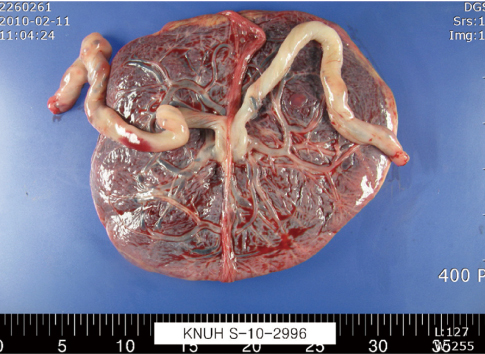Korean J Obstet Gynecol.
2011 Jun;54(6):304-307. 10.5468/KJOG.2011.54.6.304.
Antepartum spontaneous rupture of the intertwin-dividing membrane in monochorionic diamniotic twins; Nearly adhered cords
- Affiliations
-
- 1Department of Obstetrics and Gynecology, Kyungpook National University School of Medicine, Daegu, Korea. wjseong@knu.ac.kr
- KMID: 2274039
- DOI: http://doi.org/10.5468/KJOG.2011.54.6.304
Abstract
- Umbilical cord entanglement has been reported to occur in monoamniotic twins. However, it can occur in diamnionic twins due to rupture of the intertwin-dividing membrane, and is a cause for concern. A 31-year-old nullipara visited our hospital at 28+3 weeks gestation. A monochorionic diamniotic twin gestation was diagnosed ultrasonographically by visualizing a thin intertwin-dividing membrane and a single placenta. A cesarean section was performed at 35+3 weeks gestation and concordant twin fetuses with entangled umbilical cords were delivered. Gross examination revealed a single placenta with a ruptured dividing membrane. Our case, along with the other cases, confirms that antepartum rupture of an intertwin-dividing membrane is a clinical condition that should be considered in all cases of monochorionic diamniotic twin. A careful inspection of the dividing membrane and each cord insertion site should be performed. Once the dividing membrane cannot be easily visualized, the possibility of antepartum rupture should be suspected.
Keyword
MeSH Terms
Figure
Reference
-
1. Benirschke K. Twin placenta in perinatal mortality. N Y State J Med. 1961. 61:1499–1508.2. D'Alton ME, Simpson LL. Syndromes in twins. Semin Perinatol. 1995. 19:375–386.3. Sebire NJ, Snijders RJ, Hughes K, Sepulveda W, Nicolaides KH. The hidden mortality of monochorionic twin pregnancies. Br J Obstet Gynaecol. 1997. 104:1203–1207.4. Lee CY. Management of monoamniotic twins diagnosed antenatally by ultrasound. Am J Gynecol Health. 1992. 6:25–27.5. Nasrallah FK, Faden YA. Antepartum rupture of the intertwin-dividing membrane in monochorionic diamniotic twins: a case report and review of the literature. Prenat Diagn. 2005. 25:856–860.6. Gilbert WM, Davis SE, Kaplan C, Pretorius D, Merritt TA, Benirschke K. Morbidity associated with prenatal disruption of the dividing membrane in twin gestations. Obstet Gynecol. 1991. 78:623–630.7. Krause HG, Goh JT. Cord entanglement in monochorionic diamniotic twins. Aust N Z J Obstet Gynaecol. 1998. 38:341–342.8. Megory E, Weiner E, Shalev E, Ohel G. Pseudomonoamniotic twins with cord entanglement following genetic funipuncture. Obstet Gynecol. 1991. 78:915–917.9. De Lia JE, Worthington D. Intrauterine sling with umbilical cord entanglement in diamniotic twins. Ultrasound Obstet Gynecol. 2000. 15:447.10. Chen SE, Trupin L, Trupin S. Antepartum rupture of diamniotic membranes separating monozygotic twins. A case report. J Reprod Med. 1994. 39:67–70.11. Chmait RH, Aghajanian P, Kontopoulos EV, Quintero RA. Prenatal diagnosis of spontaneous septostomy of the dividing membranes in complicated monochorionic diamniotic multiple gestations. J Ultrasound Med. 2009. 28:663–668.
- Full Text Links
- Actions
-
Cited
- CITED
-
- Close
- Share
- Similar articles
-
- Prediction of Amnionicity Using the Number of Yolk Sacs in Monochorionic Multifetal Pregnancy
- Confined Blood Chimerism in Monochorionic Diamniotic Dizygotic Twin
- Twin anemia polycythemia sequence in a dichorionic diamniotic pregnancy: a case report
- Prenatal diagnosis of spontaneous twin anemia-polycythemia sequence and postnatal examination of placental vascular anastomoses
- Comparison of pregnancy outcomes based on chorionicity between spontaneous and in vitro fertilization twins



